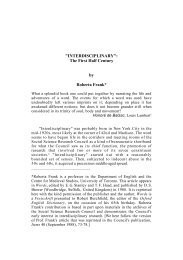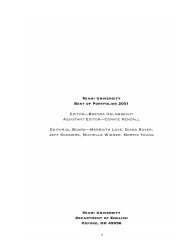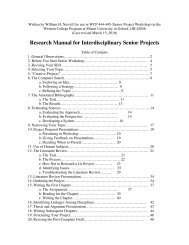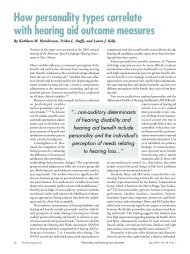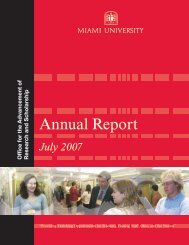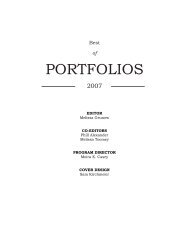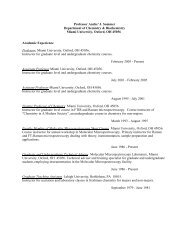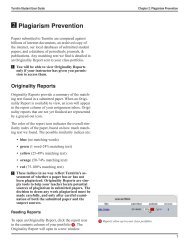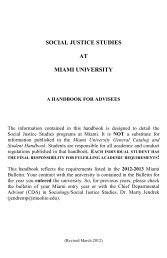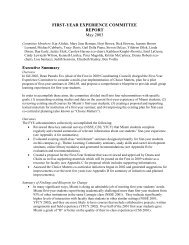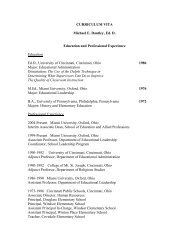The Steppes: Crucible of Eurasia - units.muohio.edu - Miami University
The Steppes: Crucible of Eurasia - units.muohio.edu - Miami University
The Steppes: Crucible of Eurasia - units.muohio.edu - Miami University
You also want an ePaper? Increase the reach of your titles
YUMPU automatically turns print PDFs into web optimized ePapers that Google loves.
came to the fore after M.I. Rostovtseff’s seminal English publication on the Iranians and Greeks<br />
in South Russia in 1922. Nevertheless, these traditional concepts <strong>of</strong> art history from the<br />
beginning <strong>of</strong> the 20th century forged an Orientalist ideal <strong>of</strong> animal art and early nomads that still<br />
continues to be drawn upon to the present day.<br />
When we place these zoomorphic artefacts on display in a museum they become isolated<br />
and disparate objects intermixed with varying items from other cultures in time and space. Set on<br />
a neutral background under focused light in the display case their exoticness becomes the focus<br />
<strong>of</strong> attention. <strong>The</strong>re is no doubt to our eyes that many <strong>of</strong> these animal decorations are beautiful to<br />
look at; however, appreciating their visual aesthetics is only one aspect in the greater range <strong>of</strong><br />
sensory experiences connected to objects. Moreover, this was not how the art was originally<br />
intended to be perceived as the gallery is a contrived effect far removed from the actual living<br />
context <strong>of</strong> the animal imagery. As ethnographic studies have pointed out time and time again, the<br />
reality <strong>of</strong> material culture exists within the lives <strong>of</strong> their owners and users. Thus, Scytho-Siberian<br />
zoomorphic decorations were not solely objects <strong>of</strong> art but were intimately entangled in the daily<br />
lives <strong>of</strong> people within past societies.<br />
This entanglement is examined through a selection <strong>of</strong> case studies that focus upon<br />
different aspects <strong>of</strong> the lives <strong>of</strong> animal decorations and zoomorphic imagery. Within the early<br />
nomadic archaeological cultures <strong>of</strong> Kazakhstan, the Altai Republic and Tuva the animal images<br />
were intimately related to how individuals created and asserted their own identities through their<br />
choices <strong>of</strong> decoration on and <strong>of</strong>f their bodies, as well as the bodies <strong>of</strong> their horses. Moreover, the<br />
zoomorphics and their applications to various media embodied ‘ways <strong>of</strong> sensing’ by different<br />
societies. In particular, so-called ‘animal style’ iconography carved in the natural rock at<br />
petroglyph sites was part and parcel <strong>of</strong> sensual experiences <strong>of</strong> places and spaces in the landscape.<br />
Overall, animal decorated objects were not artefacts that operated autonomous to society<br />
but co-existed in dynamic relationships with individuals in their communities; the lives <strong>of</strong> the<br />
zoomorphic ornamentations were intimately entangled within people’s lives. Thus, it is by the<br />
closer scrutiny <strong>of</strong> their contextual complexity, as well as exploring their sensuous aspects, which<br />
enable us to explore fresher understandings about animal art in past societies in Central Asia<br />
during the first millennium BCE.<br />
Sergey Miniaev, Institute <strong>of</strong> the History <strong>of</strong> Material Culture, Russian Academy <strong>of</strong> Sciences, St.<br />
Petersburg (ssmin@yandex.ru)<br />
Ordos Style Bronzes in Russia: New Discoveries<br />
In recent years during scientific digs in Xiongnu archaeological sites in Russia a lot<br />
bronzes <strong>of</strong> “Ordos style” were found. <strong>The</strong> great value <strong>of</strong> the collection is that the objects were<br />
found in undisturbed tombs. Now we can know the disposition <strong>of</strong> all finds in the tombs and the<br />
function <strong>of</strong> every find. <strong>The</strong> majority <strong>of</strong> the “Ordos bronzes” were found on women’s and men’s<br />
belts. <strong>The</strong> sizes and quantity <strong>of</strong> details on the belts depended on the sex, age and social position<br />
<strong>of</strong> the owner.<br />
Thanks to new finds we can present different versions <strong>of</strong> Xiongnu belt sets, from the<br />
simplest belt to the most complicated. <strong>The</strong> most complicated belt consisted <strong>of</strong> the central part<br />
(two bronze plaques as a rule; many plaques had a special wood lining) and diverse other details<br />
- small plaques, open-work rings, small rings, fastenings, buttons, buckles etc. Besides, the belt<br />
frequently was decorated with different beads and buckles made from minerals. All bronze<br />
plaques have scenes in “Ordos style”: a skirmish between two horses, a beast <strong>of</strong> prey catching a<br />
9



